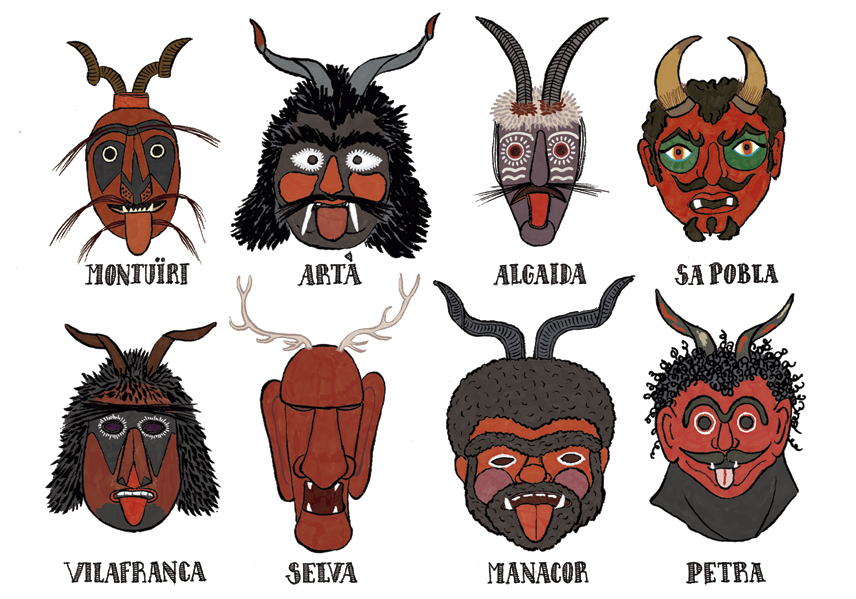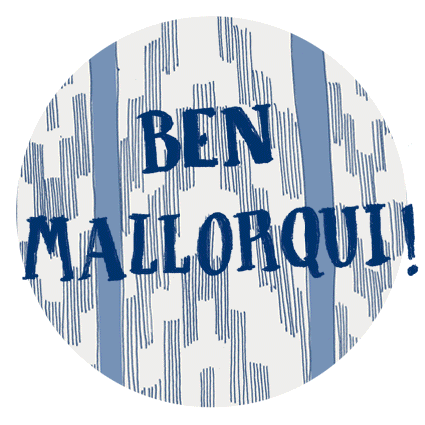
Dimonis
De petita em feien molta por i de gran tampoc els hi he perdut. A Mallorca la figura del dimoni està molt present en qualsevol acte festiu d’hivern o d’estiu, patronal o de caràcter tradicional del calendari cristià, i també és molt important en les nostres rondalles. Però, francament, a mi mai m’han generat confiança. Quan els meus avis em portaven a alguna festa a Mallorca, la idea que pogués aparèixer el dimoni m’estressava moltíssim: genera crits, rialles, xiscles i por! Una de les frases més habituals per aturar a un mallorquí nen quan està a punt de fer una malifeta és dir-li: “Que vindrà el dimoni!” i, creieu-me, segur que atura en sec. Això ho diu tot.
Però no hi ha festa a Mallorca sense dimonis! Provenen de les nostres arrels cristianes i agrícoles i, per tant, no és estrany que acompanyin el santoral en celebracions d’origen agrari. Aquests símbols de maldat i temptació humana solen representar els set pecats capitals, i la lluita entre el bé i el mal. Normalment van vestits amb un mono de tela de sac, decorat amb motius de foc, serps i ossos, i porten una gran carota, amb diferents atributs diabòlics, unes banyes, els ullals, molt de pèl fosc, i el so de la xeremia amenitza el seu ball… A cada poble tenen les seves pròpies característiques i noms; n’hi ha que solen portar una cua llarga amb un picarol a la punta i els nens juguen a estirar-li dissimuladament fins que el dimoni ho nota i genera grans corregudes i xiscles. Altres porten una barrota amb la que marquen el seu espai i posen a ratlla a la gent. Els d’Ariany porten una gran cabellera rossa. N’hi ha que tenen unes orelles enormes i d’altres són de color verd.
Ja veieu que hi ha moltes menes de dimonis però, per fer-ho més fàcil, podríem dividir-los en tres grans grups: els santantoniers provenen de pobles com Alcúdia, Artà, Colònia de Sant Pere, Capdepera, Llucmajor, Manacor, Portocristo, Muro, Sa Pobla, Sant Llorenç, Son Carrió i Son Servera. Participen la setmana del 16 al 20 de gener en les festes de Sant Antoni i, entre foc i bestiar, representen les temptacions del religiós… Aquest dimonis enceten les festes de bon matí amb un ball que es va repetint per diferents indrets del poble mentre la gent els va seguint com a comparsa. És molt conegut el Ball del Dimoni Gros de Manacor, que fins i tot entra a ballar a la sala de plens de l’Ajuntament! Més tard els dimonis s’encarregaran d’encendre els foguerons i s’hi passegen fent el seu ball.
En segon lloc tenim els Dimonis de festa. Estan presents a les festes patronals, acompanyen a la beata i solen ballar amb uns antagonistes, els cossiers, que entren dins les esglésies mentre els dimonis esperen fora repartint estopa als nens i empaitant-los per tot el poble. Els més conegut son els d’Algaida i Montuïri.
I en tercer lloc, els dimonis de foc, de tradició més moderna. Són els encarregats de fer els famosos correfocs i estan vinculats a festes del foc com Sant Joan. Hi trobam representades les colles d’Alaró, Binissalem, Costitx, Felanitx, Muro, Sa Pobla, Sant Joan, Mancor de la Vall, Sineu, Santa Maria, Sóller i Son Sardina.
I per acabar, el meu consell: si vos trobau un dimoni, correu!
I was really scared of them when I was little and I still am, even if I am a grown-up. In Mallorca, the figure of the demon is highly present in any festivity: summer or winter time, patronal or traditional from the Christian calendar. They are also very important in our tales. But, frankly, they never gave me confidence. When my grandparents took me to a feast in Mallorca, the idea that the demon could appear any time stressed me out: it generated shouts, laughter, screams and fear! One of the most common phrases to stop a Majorcan child when he is about to be naughty is to say: “The demon will come!” And, believe me, they will surely stop right away. That says it all.
But there is no festivity in Mallorca without demons! They come from our Christian and agricultural roots and, therefore, it is not strange that they accompany the calendar of saints in celebrations of agricultural origin. These symbols of evil and human temptation usually represent the seven capital sins and the struggle between the good and the evil. They are usually dressed in a sackcloth jumpsuit, decorated with fire motifs, sneaks and bones, and carry a large mask with different diabolic attributes such as horns, tusks and a lot of dark hair, while the sound of xeremies (a type of bagpipe native to the island of Mallorca) enlivens their dance… They have different characteristics and names in each town and village. There are some that usually carry a long tail with a jingle bell at the tip and children play and try to pull it until the demon notices and starts great chasings, runs and screams. Others carry a massive stick with which they mark their space and put people at bay. Those in Ariany wear a great blonde wig. Some have huge ears and others are green.
You can see that there are many types of demon but, to make it easy, we will divide them in three big groups. One of them is the Santantoniers, who come from villages such as Alcúdia, Artà, Colònia de Sant Pere, Capdepera, Llucmajor, Manacor, Portocristo, Muro, Sa Pobla, Sant Llorenç, Son Carrió i Son Servera. During the week of the 16th to the 20th of January, they participate in the festivities of Sant Antoni and, between fire and livestock, they represent the temptations of the religious… This demon starts the festivities early in the morning with a dance that is repeated in different places of the town while people follow them in a parade. The Ball del Dimoni Gros de Manacor (which would translate as the Big Demon’s Dance in Manacor) is very well-known. He even enters the Chamber of the Town Hall to dance! Later on the day, the demons will be in charge of lighting the bonfires and they will go around performing their dance.
Next, we have the Festivity Demons. They are present in the patronal fests, go along with the beata and usually dance with their antagonists, the cossiers, who enter the churches while the demons wait outside giving tow to the children and chasing them around the whole town. The best known are those from Algaida and Montuïri.
Finally, the Fire Demons, which constitute a more modern tradition. They are responsible for making the famous correfocs and are linked to fire festivities such as Sant Joan. We find represented the groups from Alaró, Binissalem, Costitx, Felanitx, Muro, Sa Pobla, Sant Joan, Mancor de la Vall, Sineu, Santa Maria, Sóller and Son Sardina.
Finally, my personal piece of advice: if you bump into a dèmon, run!
Text by Ben Mallorquí


+ There are no comments
Add yours